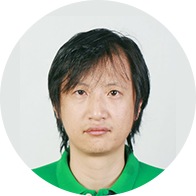

Fan Jin is a Professor in Shenzhen Institute of Advanced Technology (SIAT), Chinese Academy of Sciences,Prof.Jin received his Bachelor degree in Department of Applied Chemistry from University of Science and Technology of China in 2002, He obtained a PhD in Molecular Physical Chemistry from The Chinese University of Hong Kong, He has held postdoctoral positions at Illinois State University Champaign and the University of California, Los Angeles.
Dr. Jin’s main research direction is the new method of quantitative and evolutionary biology, using its controllable biological chassis and new fund lines to try to solve major problems directly related to the environment and health. He has presided over 6 national fund projects, of which 5 have been completed and 1 is under study.
TEL.:0755-26409621
EMAIL: fan.jin@siat.ac.cn
WEBSITE:http://jin.isynbio.siat.ac.cn
Publications/Patents (recent)
Wang, C.#, Chen, W.#, Xia, A., Zhang, R., Huang, Y., Yang, S.,Ni, L.*, Jin, F.* (2019). Carbon starvation induces the expression of PprB-regulated genes in Pseudomonas aeruginosa. Appl. Environ. Microbiol., 85: e01705-19.
Han, J.#, Xia, A.#, Huang, Y., Ni, L., Chen, W., Jin, Z., Yang, S.*, Jin, F.* (2019). Simultaneous Visualization of Multiple Gene Expression in Single Cells Using an Engineered Multicolor Reporter Toolbox and Approach of Spectral Crosstalk Correction. ACS Synth. Biol., 11, 2536-2546.
Armbruster, CR., Lee, CK., Parker-Gilham, J., de Anda, J., Xia, A., Zhao, K., Murakami, K., Tseng, BS., Hoffman, LR., Jin, F., Harwood, CS., Wong, GCL.*, Parsek MR. * (2019). Heterogeneity in surface sensing suggests a division of labor in Pseudomonas aeruginosa populations. eLife, 8, e45084.
Xia, A.#, Yang, S.#, Zhang, R., Ni, L., Xing, X.*, Jin, F.* (2019).Imaging the Separation Distance between the Attached Bacterial Cells and the Surface with a Total Internal Reflection Dark-Field Microscope. Langmuir, 35(26):8860-8866.
Lee, EY., Zhang, C., Di, DJ., Jin, F., Connell W., Hung, M., Malkoff, N., Veksler, V., Gilliet, M., Ren, P., Wong, GCL.* (2019). Helical antimicrobial peptides assemble into protofibril scaffolds that present ordered dsDNA to TLR9. Nat. Commu., 10(1), 1012.
1. A multicolor fluorescent reporter toolbox to simultaneously monitor the activities of multiple genes in single cells.
2. A prism-based total internal reflection dark-field microscope (p-TIRDFM) combined with the microfluidic method to image the separation distance of single attached cells.
3. A method capable of detecting single slow-growing and growth-arrested cells in a bacterial culture composed of physiologically and phenotypically different cells.
4. Some mechanisms in biofilm development and formation of P. aeruginosa.
5. Some mechanisms involving motility mode of P. aeruginosa.